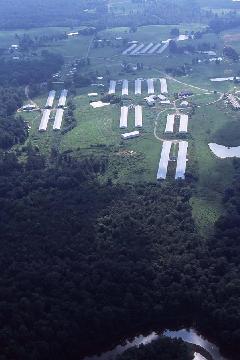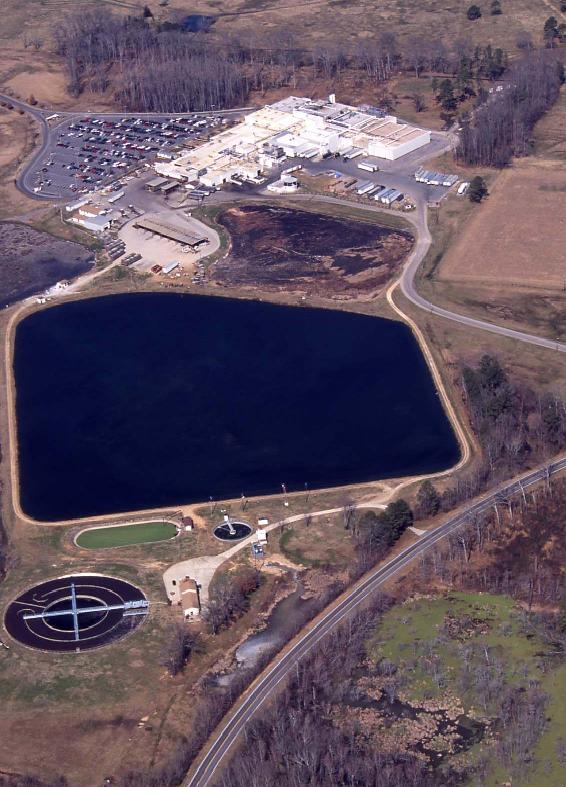Chicken CAFOs (concentrated animal feeding operations) Map [created by Riverkeeper]
https://drive.google.com/open?id=1bIRTEfDjKj2wplmwj2vRMzcKJ3If8VPK&usp=sharing
(the “Unregistered AFO/CAFO Facilities” were mapped visually without ground verification, so there is potential for some to be empty, inactive, storage, other)
Alabama is one of the largest poultry producers in the United States, trailing only Arkansas and Georgia in terms of broiler chicken production. The Alabama Farmers Association estimates that Alabama marketed more than one billion birds and over two billion eggs in 2004. Poultry production in Alabama is highly concentrated in ecologically vital areas of the Black Warrior River basin in the northern part of the state, particularly Cullman and Blount Counties. Cullman County alone reported producing over 163 million broilers between 2002 and 2003, leading the state, while Blount County ranked fourth. The Black Warrior River’s Mulberry and Locust Forks flow through this area. Both Forks, which are meccas for kayaking and eco-tourism, have begun to show impaired water quality and marked decreases in indigenous fish species, according to Mettee, O’Neil, and Pierson’s Fishes of Alabama and the Mobile Basin. The modern Concentrated [or Confined] Animal Feeding Operation (CAFO) is a substantial source of this problem.
Over the last 50 years, USDA economic policy adjustments and subsidy programs have shifted America’s agricultural system from a sustainable network of family farms to an intensely mechanized industrial system. This production shift made it cost-prohibitive for most farmers to feed their animals on their own farm land. USDA agricultural policies have essentially encouraged farmers to grow as much corn as possible and fatten their livestock en masse in facilities that are known as CAFOs. Today, instead of a few chickens being raised on a diet of grass and insects on a pasture or chicken yard, thousands are crammed into unimaginably tight quarters where they produce massive amounts of fecal waste. This waste has a nasty habit of making its way into waterways.
The health and ecological hazards of mismanaged CAFO waste are myriad. CAFOs are loud, nauseatingly smelly, sanitation nightmares. Disease tends to spread more quickly among animals kept in close confinement, which is one of the reasons our chickens are pumped full of antibiotics. The major threat to water quality is the astronomical amount of excrement generated in a CAFO. The most popular solution for dealing with this overflow of waste is to dry it and apply it as fertilizer to surrounding pastures.
This is a poor solution. Chicken manure is a particularly “hot” fertilizer, meaning that it is rich in nitrogen and phosphorous. A given pasture area can only absorb so much hot fertilizer before it begins to damage the pasture itself and run off into local waterways. Auburn’s College of Agriculture estimates that around three times as much animal waste is produced in northeastern Alabama than could be used as fertilizer in the entire state. The thin sandy soils of northeast Alabama simply cannot absorb the astonishing amount of animal waste. Pathogenic microbes found in chicken waste can infect humans, causing a number of illnesses including gastrointestinal disease and kidney problems. High nitrate levels in drinking water increase the risk of “blue baby syndrome” which can prove fatal for newborns. People who live near CAFOs are exposed to the stench produced by housing so many chickens in such a confined space. Residents near CAFOs often complain of dizziness, sore throats, chronic coughing, diarrhea and other ailments. Waste runoff brings fish kills, oxygen depletion, algae blooms and many pollutants.
Alabama’s historically impotent Department of Environmental Management (ADEM) holds the responsibility for ensuring that CAFOs comply with all Federal and State regulations. Generally, violators are only held accountable when local residents and environmental groups use the citizen enforcement provisions of state and federal environmental laws. Bryan Burgess of Rural Friends of Alabama has used aerial surveillance techniques to identify up to 3,200 CAFO facilities (ADEM’s website only lists around 500 of the larger permitted facilities). Many of these smaller facilities may be polluting with impunity. Burgess has successfully forced CAFOs into compliance and prevented new ones from being built.
Cheap corn is the engine that drives the CAFO and makes our chicken cost less. Yet CAFOs do so by externalizing the hidden environmental and health costs of the chicken production. As consumers, each of us has a voice that speaks loudly: our wallets. We can buy our meat and eggs from suppliers that raise animals naturally, humanely, organically, and locally. Many supermarket retailers, such as Wal-Mart, are beginning to take notice. Please visit http://www.pewtrusts.org/news_room_detail.aspx?id=38438 for more information on CAFOs and what you can do to make a difference. To view a map of chicken broiler production in Alabama, click here.
Special Guest Author Peter Castleberry is a Black Warrior Riverkeeper volunteer CAFO researcher.
Photos in slideshow by Nelson Brooke, Bryan Burgess, Mark Martin


Left: Chicken Factory Houses near Catoma Lake part of Eightmile Creek of the Mulberry Fork (Cullman Co.)
Right: Tyson Chicken Processing Plant in Blountsville (Blount Co.)
Photos by Bryan Burgess, Friends of Rural Alabama












